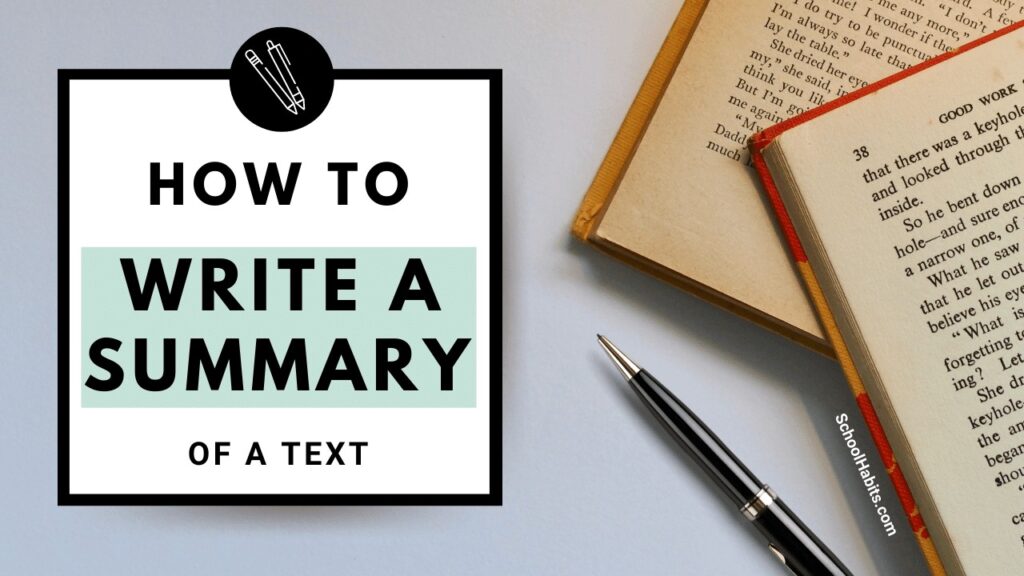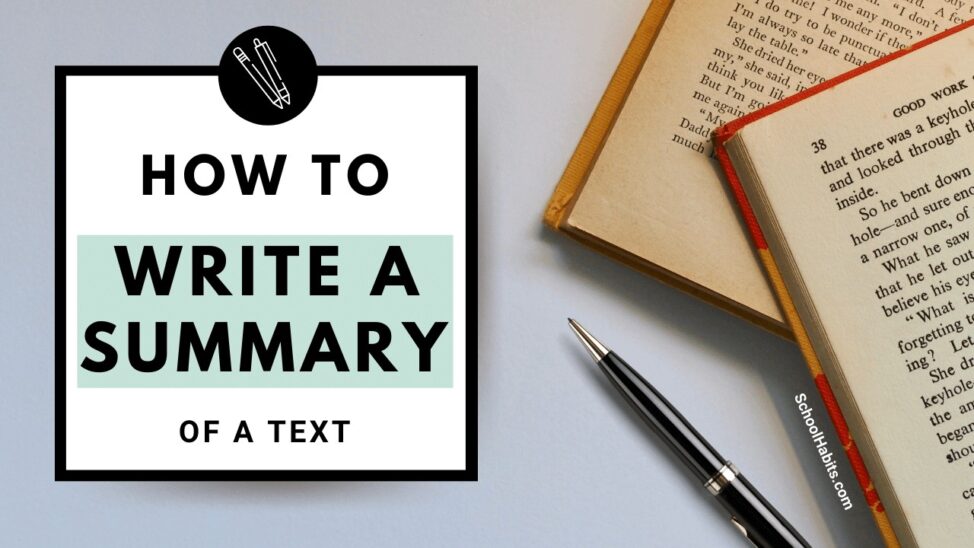
By Katie Azevedo, M.Ed.
Knowing how to write a summary of a text is one of the most important skills for school and work. It’s even important outside of school, like in everyday conversations with people (Hey, what was that movie about? How’s that book you’re reading? Tell me about your day!).
The ability to summarize text is the foundation of SO many other academic skills such as taking notes, annotating, writing essays, writing reports, and studying. If you can’t summarize, all of those other skills become that much harder.
What is a summary?
There are lots of misunderstandings about writing summaries. Let’s start with a very important clarification about what a summary IS and is NOT.
- A summary IS a general description of the main idea of the text.
- A summary is NOT a shortened version of text, a paraphrase, or a play-by-play account of plot points.
What to put in a summary
- The main topic or theme of the passage. This will be a broad idea like racism, finding one’s identity, political conflict, etc.
- The purpose of the passage (what does the author want you to learn?)
- Names of key people (usually just 1-2), and only if they’re connected to the main idea
- Important dates (usually just 1-2)
- The author and title of the text, if you’re taking notes on an article or novel
What NOT to put in a summary
- Small details
- Descriptive language (keep your language simple + avoid adjectives)
- Information that’s interesting to you but not important to the main idea
- Names and dates, unless they are related to the main idea
- Your opinion or assumptions
- Exact language and quotations from the passage
How to write a summary in 6 steps
The strategy I outline below is a complete summarization strategy for text that’s at least a page in length. For text that’s shorter in length, such as a paragraph, simply follow steps 2-5.
1. Read small chunks of text at a time.
Whether you’re reading an article, textbook, or book, read somewhere between one and two paragraphs at a time, depending on the difficulty of the material. Working with small batches of text at a time is helpful for comprehension. If you don’t comprehend what you’re reading, writing a summary is impossible.
2. Highlight and rewrite as you read.
As you read your chunk of text, highlight or underline the main ideas you think are important. Accompany most of your highlights with a few simple margin notes. Here’s exactly how to use my highlight and rewrite strategy.
More tips:
- Main ideas are usually stated in the first few sentences and are repeated at the end of the paragraph.
- The middle text often contains vocabulary, examples, and additional details.
- One to three highlights per section of text is usually the right amount.
3. Make sure you understand the text.
Writing a summary of a text is impossible if you don’t understand what you’re reading. Really. Actually. Know this. If you’re reading challenging material, you may end up spending more time comprehending the text than you spend writing your summary – this is okay. Here are some tips for comprehension:
- Notice when something is unclear to you.
- Stop reading if you zone out, and then restart the sentence. Here are 6 zone-out tips.
- If you don’t understand something, re-read it or look it up.
- When you’ve finished reading your chunk of text, ask yourself how much you understood what you read, on a scale of 1-10. You should be at least a 7. If not, re-read it.
- You don’t need to understand everything you read in order to create a general summary of the material.
4. From your memory, reconstruct the author’s main argument as if you are teaching it to a six-year-old.
It’s very important not to look at the text for this step. You must rely on your memory. This is doable, as you only just read the paragraph a moment ago. More tips:
- Write your summary in the margins. This should only be a few sentences or a few bullet points.
- Don’t use the author’s exact words.
- Use simple language, as if you are really talking to a young child.
- If you can’t recall exact names, facts, dates or small details, leave it out of your summary. (They don’t belong there anyway.)
5. Match your summary to your highlights.
After you’ve written your summary from memory, go back into the text and see if your summary includes most of the ideas you highlighted. If not, consider if you should add those details. But also, maybe you don’t need to.
6. Combine your smaller summaries.
If the text you’re reading is longer than a paragraph, you’re going to have multiple summary statements written in the margins. In order to produce a single summary for the entire text, you’re going to need to combine your paragraph summaries. Here’s how to do this:
- Read each of your paragraph summaries in sequential order, from the first paragraph to the last.
- Next, just like in step 5, attempt to put those summaries together without looking at them.
- Do this on paper, not in your head.
- When you’re done, check to see if what you wrote contains most (not all) of the information from your margin summaries. If you’ve missed something important, add it in.
- If possible, your summary should incorporate who, what, when, where, how and why.
Final notes on how to write a summary of a text
Like any skill, learning how to write a summary takes time and practice. The longer and more complicated the text, the more effort it will take. Just remember, your summary should take a 10,000-foot view, and not a 1,000-foot view of the text; in other words, it shouldn’t be written like “first this happened, then this happened, then so-and-so said this, and then she said that …”
Below, I’ve summarized this tutorial so you can better understand how a summary works. I’ve incorporated who, what, why, and how. I’ve left out where and when because they’re irrelevant.
Summary example:
In an effort to share knowledge (why), Katie Azevedo of SchoolHabits.com (who) teaches how to write a summary of a text (what) by defining what it is, explaining what information to include and exclude, and outlining 7 specific summarization steps (how).
More writing resources:
- How to write an essay in a week (or less!)
- Free Essay Editing Checklist (it’s a good one! I promise)

